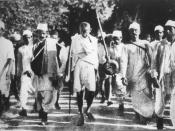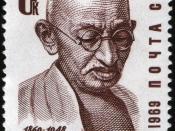Gandhiji Experiment with Satyagraha
Champaran Satyagraha (1917).
Mahatama Gandhi began his experiments with Satyagraha at a small scale at Champaran in Bihar in 1917. Here, the European indigo planters used to be very oppressive. The brunt of their oppression used to fall directly on the plantation workers. Besides, the planters were forcing the peasants to cultivate indigo in at least 3/20 parts of their land and also to sell their products at a very low price. All such harassment meted out to them has found vivid description in Tarashankar Bandhopathyay's novel Neel Darpan. These distressed indigo farmers had been greatly impressed by Mahatma Gandhi's successful movements in South Africa. So they invited him to hamparan to find a way out of their hardship. Mahatma Gandhi went to Champaran and himself saw the distress which the indigo farmer were undergoing. The district officials became infuriated at the arrival of Mahatma Gandhi in Champaran and ordered him to leave the place immediately.
But Mahatma Gandhi defied the order and prepared to launch his first satyagraha. The government could sense the gravity of the situation and the order to ask Mahatma Gandhi to leave Champaran was withdrawn. A decision was also taken by the government to set up a Committee of enquiry of which Mahata Gandhi himself was made a member. The Committee of Enquiry recommended some measures to alleviate the miseries the indigo cultivators thereby bringing the satyagraha to an end. From this early experiment with satyagraha at a local level, Gandhiji could directly acquaint himself with the miserable condition of the Indian farmers and also the difficulties faced them. Besides, Mahatma Gandhi also realized that satyagrha could be used as a means of struggle against injustice and foreign rule in India as well.
Kheda Satyagraha (1918)
The movement launched by the...


